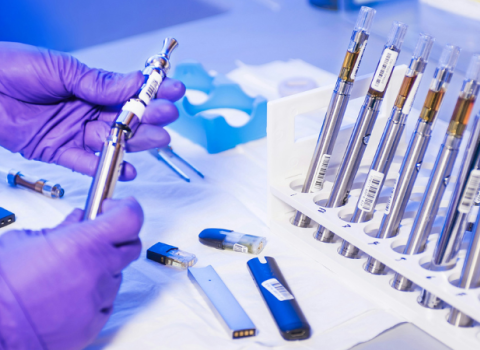A team of biologists, clinical oncologists, pathologists and information scientists has established a strategy for identifying biomarkers. If a particular pattern of these biomarkers can be detected in the blood, this indicates a cancerous disease. An interdisciplinary research breakthrough that opens many doors.
Very soon a small finger-prick may provide the basis for the reliable diagnosis and characterisation of a vast variety of cancer types. Present-day diagnosis methods, which detect tumour antigens in the blood, often yield false results. Not only is this expensive, but patients must also subsequently undergo painful biopsies. In contrast, the diagnosis method for prostate cancer, presented after five years of research by an interdisciplinary group of scientists from ETH Zurich, University Hospital Zurich and the Cantonal Hospital of St.Gallen, is highly precise. The researchers' work which is going to be published in the next issue of PNAS also offers a generally applicable strategy for identifying biomarkers. This also brings the early diagnosis of other cancer types within reach. Moreover, the biomarker pattern contains information about the type of tumour, which helps to ascertain the best possible therapy to be adopted.
Strategic approach
The scientists' approach in their search for biomarker patterns indicating prostate cancer was extremely focused. The starting point for the research work was the "Pten" gene, which is inactivated in 60% of all prostate cancer patients and leads, for example, to uncontrolled cell growth. These enabled the researchers to ensure a high probability that the subsequent steps, which were carried out in mice as a model organism, would also be relevant to humans. In the first step, the scientists inactivated the "Pten" gene specifically in the mouse prostate. They then identified hundreds of prostate surface proteins in healthy mice, and also in those mice which had developed prostate cancer due to the inactivated gene. Next the researchers compared the protein sets from the healthy mice with those from the cancerous mice. From this they determined a pattern of proteins that is typical of the mutated version of "Pten" and thus also for prostate cancer.
Back to humans
In the second step, the scientists wanted to find out whether the findings from the mouse model were also relevant to humans. They did this by examining tissue and serum samples from prostate cancer patients and a control group. Based on the list of specific proteins drawn up using the mouse model, the researchers identified 39 corresponding proteins in the humans that indicated prostate cancer. The information scientists used more than 20,000 models to calculate the four proteins that enabled the most reliable diagnosis to be made. «We then used this biomarker pattern to examine a cohort of patients whose blood had never previously been analysed. We were able to predict with precision, stability and reproducibility whether they were suffering from prostate cancer», says Wilhelm Krek, professor of Cell Biology at ETH Zurich. Of course, this new biomarker signature needs now be to further validated in a larger clinical trial. The development of this highly promising project is being undertaken by the ETH Zurich spin-off company Proteomedix AG, which is currently developing a diagnosis kit.
In the beginning there was the gene
The biomarker strategy is based on the concept that the onset of cancer triggered by a mutation, such as the inactivation of a gene, is associated with a change in the protein pattern in the affected organ. Since approximately 20% of the surface proteins of certain tissues, including the prostate, can be separated off and detected in the serum, the detection of this kind of protein pattern, which is specific to the illness, represents a reliable potential method of diagnosis.
For many years, scientists have been using a wide variety of high-tech methods in an attempt to identify biomarkers that reliably indicate cancerous disease. Until now this task represented a major challenge, and sometimes measurements were made and analysed quite aimlessly. «The protein patterns that were determined may have reflected the patients' eating habits, but were unable to provide any indication about whether or not a cancerous disease was present», explains Krek. The highly promising research results that have now been produced offer an impressive demonstration that interdisciplinary collaboration between researchers, in this case cell biologists, proteomics experts, pathologists, clinical oncologists and information scientists, is often the only way to achieve success.





 A unique international forum for public research organisations and companies to connect their external engagement with strategic interests around their R&D system.
A unique international forum for public research organisations and companies to connect their external engagement with strategic interests around their R&D system.